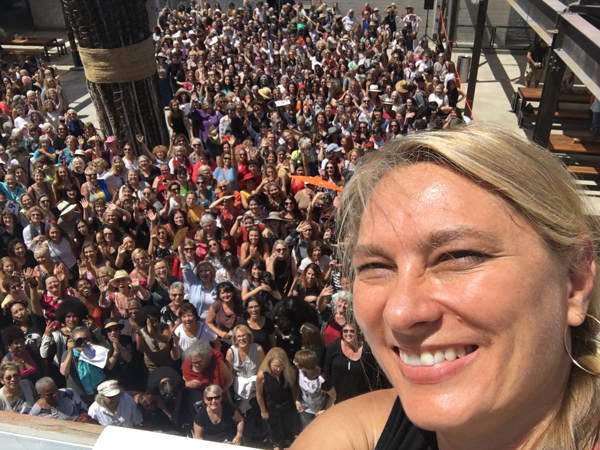When Kim Schoenstadt first asked me if I would photograph “Now Be Here LA 2016”—the historic group photograph of hundreds of LA-based women artists that she was organizing at Hauser, Wirth, & Schimmel—I simultaneously felt flattered and out of my depth.
I’m an artist and I’ve taught photography at university level for eight years, yet I don’t consider myself a commercial photographer. I’m not legit like that. For one thing, I shoot analog. How could I be expected to document such an important moment? But the politics of the piece were aligned with mine. I loved the idea of hundreds of women artists showing up, standing up, and being counted. So I said yes.
I showed up on the morning of the event as a fairly anonymous contributor. I felt a bit anxious, too, as I hadn’t had a chance to frame the shot from the roof with my Hasselblad until that morning. To steady my nerves I shot a few practice rounds of the empty courtyard baking in the LA summer sun, the downtown skyline anchored in an expanse of uninterrupted blue. If you’ve never shot medium format you may not know that you see the world in reverse when you look through the lens. This is disorienting at the best of times, much less when one is shooting on top of a rimless roof punctuated by gaping, windowless skylights. Still, after shooting some expired film, I felt connected to the space, more sure of what I was there to do.
Before the gallery opened its doors I went down to have a look at the massive line of women waiting to get in. Escaping the throngs, I went back up to the roof. Looking down through the gaps in the ceiling I saw people I knew: women I’ve taught with, been taught by, collaborated with. Famous artists, not-so-famous artists: Everyone seemed to be there, laughing, saying hello, connecting. It was an odd feeling being up there, on the outside looking in.
Then it was time to take the photo. Numbers up, so we could identify people later; numbers down for the real photo. I shot a roll of 120 and took some snaps with my iPhone, including a selfie with the crowd as they cheered, which was oddly validating. And then that was it; it was over. I posted my pics on Facebook as the crowd quickly dissipated. I said goodbye to my crit group members, drank a glass of champagne, then went to a seven-year-old’s birthday party.
That is when the Facebook notifications started pouring in. As children at the party ate cupcakes and hurled themselves down a backyard water slide, my rooftop post was going viral. Every few minutes there were another 20 notifications.
At first, I did what I normally do when someone engages with me on Facebook, I engaged back. But as more and more women tagged, liked and commented, it suddenly dawned on me that I didn’t need to respond the way I normally would. The women weren’t talking to me on my post, they were talking to each other. My post was a thread, a way of sustaining and drawing out the connections that the women had felt, made or reconnected with that day. I felt like a medium.
But the comments on my Facebook post weren’t just about connecting to the community of women artists. I began to notice comments like this one, “That’s me. Number 536.” And I realized that being there, being counted, mattered on a personal level. For so many women who struggle with feelings of legitimacy in the zero-sum, super-sexist, disconnected art world, being there, and being counted as part of that group conjured a sense of belonging. For that one day and in that one moment, women artists in Los Angeles got to decide for themselves if they counted, simply by showing up. By saying that’s me, I’m here.
It’s bittersweet, not being in the photograph. Kim tells me that my name will be on the photo in the credits, but I already see the images posted and shared in places with photo credits omitted. I tell myself I didn’t do it for the fame, I did it because it was important. But I have to admit that it is important to me to be counted—to count.
Someone saw my rooftop selfie and said, “So is that 732 plus one?”
Yep. That’s me. Number 732 plus one.



















0 Comments